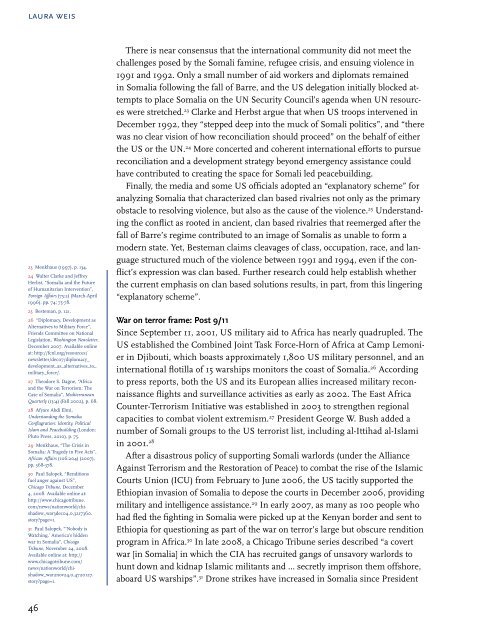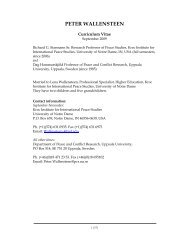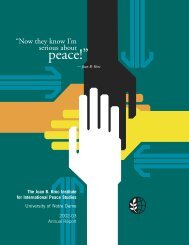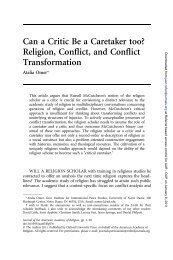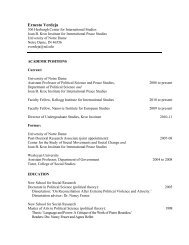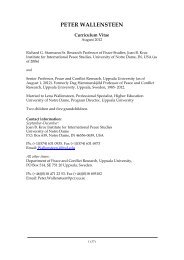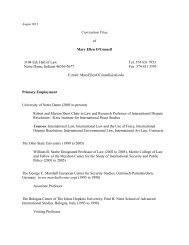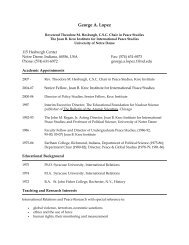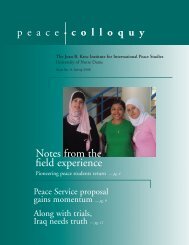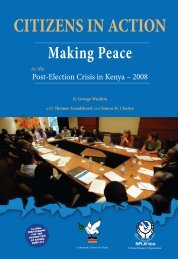Somalia: Creating Space for Fresh Approaches to Peacebuilding
Somalia: Creating Space for Fresh Approaches to Peacebuilding
Somalia: Creating Space for Fresh Approaches to Peacebuilding
Create successful ePaper yourself
Turn your PDF publications into a flip-book with our unique Google optimized e-Paper software.
laura weis<br />
23 Menkhaus (1997), p. 134.<br />
24 Walter Clarke and Jeffrey<br />
Herbst, “<strong>Somalia</strong> and the Future<br />
of Humanitarian Intervention”,<br />
Foreign Affairs (75:2) (March-April<br />
1996), pp. 74; 75-78.<br />
25 Besteman, p. 121.<br />
26 “Diplomacy, Development as<br />
Alternatives <strong>to</strong> Military Force”,<br />
Friends Committee on National<br />
Legislation, Washing<strong>to</strong>n Newsletter,<br />
December 2007. Available online<br />
at: http://fcnl.org/resources/<br />
newsletter/dec07/diplomacy_<br />
development_as_alternatives_<strong>to</strong>_<br />
military_<strong>for</strong>ce/.<br />
27 Theodore S. Dagne, “Africa<br />
and the War on Terrorism: The<br />
Case of <strong>Somalia</strong>”, Mediterranean<br />
Quarterly (13:4) (Fall 2002), p. 68.<br />
28 Afyare Abdi Elmi,<br />
Understanding the <strong>Somalia</strong><br />
Conflagration: Identity, Political<br />
Islam and <strong>Peacebuilding</strong> (London:<br />
Plu<strong>to</strong> Press, 2010), p. 75.<br />
29 Menkhaus, “The Crisis in<br />
<strong>Somalia</strong>: A Tragedy in Five Acts”,<br />
African Affairs (106:204) (2007),<br />
pp. 368-378.<br />
30 Paul Salopek, “Renditions<br />
fuel anger against US”,<br />
Chicago Tribune, December<br />
4, 2008. Available online at:<br />
http://www.chicagotribune.<br />
com/news/nationworld/chishadow_war3dec04,0,3217360.<br />
s<strong>to</strong>ry?page=1.<br />
31 Paul Salopek, “‘Nobody is<br />
Watching,’ America’s hidden<br />
war in <strong>Somalia</strong>”, Chicago<br />
Tribune, November 24, 2008.<br />
Available online at: http://<br />
www.chicagotribune.com/<br />
news/nationworld/chishadow_war2nov24,0,4720127.<br />
s<strong>to</strong>ry?page=1.<br />
46<br />
There is near consensus that the international community did not meet the<br />
challenges posed by the Somali famine, refugee crisis, and ensuing violence in<br />
1991 and 1992. Only a small number of aid workers and diplomats remained<br />
in <strong>Somalia</strong> following the fall of Barre, and the US delegation initially blocked attempts<br />
<strong>to</strong> place <strong>Somalia</strong> on the UN Security Council’s agenda when UN resources<br />
were stretched. 23 Clarke and Herbst argue that when US troops intervened in<br />
December 1992, they “stepped deep in<strong>to</strong> the muck of Somali politics”, and “there<br />
was no clear vision of how reconciliation should proceed” on the behalf of either<br />
the US or the UN. 24 More concerted and coherent international ef<strong>for</strong>ts <strong>to</strong> pursue<br />
reconciliation and a development strategy beyond emergency assistance could<br />
have contributed <strong>to</strong> creating the space <strong>for</strong> Somali led peacebuilding.<br />
Finally, the media and some US officials adopted an “explana<strong>to</strong>ry scheme” <strong>for</strong><br />
analyzing <strong>Somalia</strong> that characterized clan based rivalries not only as the primary<br />
obstacle <strong>to</strong> resolving violence, but also as the cause of the violence. 25 Understanding<br />
the conflict as rooted in ancient, clan based rivalries that reemerged after the<br />
fall of Barre’s regime contributed <strong>to</strong> an image of Somalis as unable <strong>to</strong> <strong>for</strong>m a<br />
modern state. Yet, Besteman claims cleavages of class, occupation, race, and language<br />
structured much of the violence between 1991 and 1994, even if the conflict’s<br />
expression was clan based. Further research could help establish whether<br />
the current emphasis on clan based solutions results, in part, from this lingering<br />
“explana<strong>to</strong>ry scheme”.<br />
War on terror frame: Post 9/11<br />
Since September 11, 2001, US military aid <strong>to</strong> Africa has nearly quadrupled. The<br />
US established the Combined Joint Task Force-Horn of Africa at Camp Lemonier<br />
in Djibouti, which boasts approximately 1,800 US military personnel, and an<br />
international flotilla of 15 warships moni<strong>to</strong>rs the coast of <strong>Somalia</strong>. 26 According<br />
<strong>to</strong> press reports, both the US and its European allies increased military reconnaissance<br />
flights and surveillance activities as early as 2002. The East Africa<br />
Counter-Terrorism Initiative was established in 2003 <strong>to</strong> strengthen regional<br />
capacities <strong>to</strong> combat violent extremism. 27 President George W. Bush added a<br />
number of Somali groups <strong>to</strong> the US terrorist list, including al-Ittihad al-Islami<br />
in 2001. 28<br />
After a disastrous policy of supporting Somali warlords (under the Alliance<br />
Against Terrorism and the Res<strong>to</strong>ration of Peace) <strong>to</strong> combat the rise of the Islamic<br />
Courts Union (ICU) from February <strong>to</strong> June 2006, the US tacitly supported the<br />
Ethiopian invasion of <strong>Somalia</strong> <strong>to</strong> depose the courts in December 2006, providing<br />
military and intelligence assistance. 29 In early 2007, as many as 100 people who<br />
had fled the fighting in <strong>Somalia</strong> were picked up at the Kenyan border and sent <strong>to</strong><br />
Ethiopia <strong>for</strong> questioning as part of the war on terror’s large but obscure rendition<br />
program in Africa. 30 In late 2008, a Chicago Tribune series described “a covert<br />
war [in <strong>Somalia</strong>] in which the CIA has recruited gangs of unsavory warlords <strong>to</strong><br />
hunt down and kidnap Islamic militants and … secretly imprison them offshore,<br />
aboard US warships”. 31 Drone strikes have increased in <strong>Somalia</strong> since President


